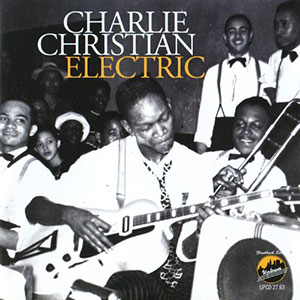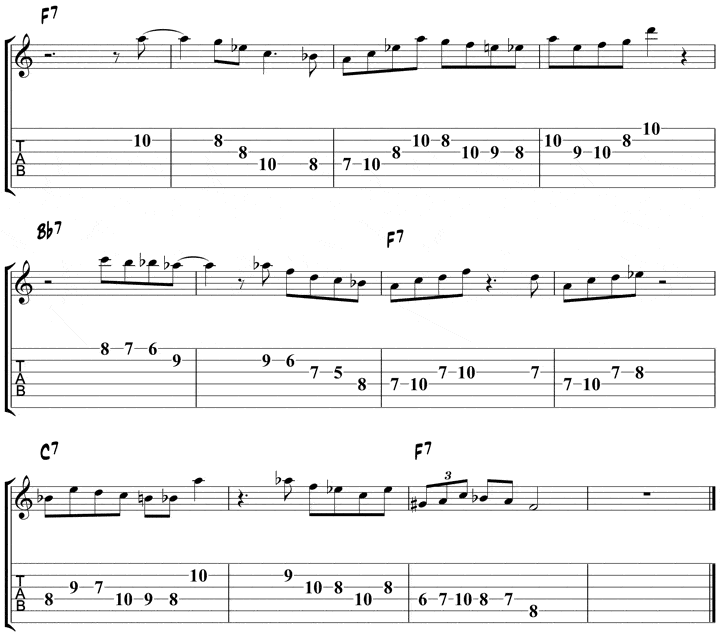Charlie Christian is the father of jazz guitar, one of the most important figures in jazz guitar history, and a favorite soloist of many jazz guitarists today. Though he never released an album as a bandleader, his recorded legacy stands to this day as some of the most exciting, and entertaining, in the jazz guitar library.

Charlie Christian was the first successful electric guitarist and although he played in swing bands mostly, he was very much influenced by bebop players.
He was a student of Eddie Durham – a jazz guitarist who invented the amplified guitar – and was one of the first guitarists who played amplified. Electric guitar opened up a range of possibilities because guitarists could concentrate on other things besides volume.
Unfortunately Charlie Christian died at the early age of 25 after contracting tuberculosis.
When learning how to play jazz guitar, studying Christian’s playing is essential for players of all musical tastes, experience levels, and backgrounds.
In this lesson, you’ll learn ten classic Charlie Christian dominant 7 chord licks, as well as a full jazz blues solo that uses those licks in its construction. Before moving on to playing the jazz blues solo at the end of this lesson, you can learn about how each of the Christian licks is built on the fretboard.
Learning these licks is important when studying Christian’s soloing concepts, but it’s the concepts that will allow you to expand this material in your playing. After you’ve understood how each lick is built, you can take those concepts and apply them to other chords, keys, and tunes.
Charlie Christian Licks List
Charlie Christian Lick 1
In this first dominant 7 lick, you’ll see how Christian liked to use the Am7b5 arpeggio to outline an F9 sound over F7 in his solos:
| Am7b5 | A | C | Eb | G |
|---|---|---|---|---|
| Played over F7 | 3 | 5 | b7 | 9 |
When soloing over dominant 7 chords, you can play a m7b5 arpeggio from the 3rd of that chord.
Another example: if you have C7, you can play Em7b5 to generate that same Christian sound in your solo.
Listen & Play Along

Charlie Christian Lick 2
This typical Charlie Christian lick is played over A7 and uses the same m7b5 substitution as in lick 1. The first 4 notes form a C#m7b5 chord shape, a common substitute for the A7 chord. It gives us the 3, 5, b7 and 9 of A7.
Licks like these are nice to play on a B section of a rhythm changes.
Listen & Play Along

Charlie Christian Lick 3
This Christian lick starts with an Adim arpeggio over F7:
| Adim triad | A | C | Eb |
|---|---|---|---|
| Played over F7 | 3 | 5 | b7 |
From there, you’ll see a passing note (the E at the end of the first bar), as well as a lower neighbor tone (the E at the start of the second bar).
Christian used less chromatic notes that later jazz guitarists, but notes such as passing notes and lower neighbor notes are found throughout his solos. It’s this application of chromatic notes that elevated his solos from just outlining the changes to being musical statements.
By working these types of chromatic notes, you too can use them to create interest, energy, and engagement in your own jazz guitar solos.
Listen & Play Along

Charlie Christian Lick 4
Moving on, this lick uses a passing note (the B in bar 1), as well as a Bb7 arpeggio in the next segment of the line.
Sometimes the best approach is the most direct approach (such as the diatonic arpeggios), and Christian used this approach often in his solos.
To finish the line, and to break the arpeggio up a bit, Christian uses a C (the 9th), as the second last note in the phrase. When soloing with arpeggios, inserting one or two scale tones, such as the 9th in this line, can go a long way to making your lines sound musical and not like an exercise.
Listen & Play Along

Charlie Christian Lick 5
Here is a very typical, and melodic Charlie Christian lick.
- The line starts with a 1-3-6 arpeggio and then ends on the root note of the underlying chord (F).
- From there, Christian repeats the same first three notes, but this time ends on the b7 of the F7 chord.
By repeating the start of the lick in both sections, Christian leads the listener through his solo but gives them variety at the end to create interest. Repetition is something Christian, and other jazz guitarists, used to great effect when creating phrases in his solos.
When soloing over jazz tunes, don’t be afraid to repeat yourself, using slight differences as Christian did to lead the listener along the way in your solos.
Listen & Play Along

Charlie Christian Lick 6
The next lick uses another passing note, which you can see Christian loved to use in his solos, as well as the F minor blues scale to create a V7-I7 line at the end of the blues.
Notice the G# (the b3) of the F7 chord at the end of the line.
Playing the b3-3 (as you’re doing here with G#-A), was a typical sound from Christian’s era, and one that has stuck in the jazz vocabulary until this day. Because of its longevity, using this approach in your own solos is an essential sound to have under your fingers and in your ears.
Listen & Play Along

Charlie Christian Lick 7
In this classic Christian sounding lick, the major blues scale is being used to outline an A7 chord, producing a bluesy, swing-sounding lick.
Using the major blues scale (the major pentatonic scale with an added b3) is a great way to bring a Christian and swing sound to your lines, so feel free to explore this idea further.
Listen & Play Along

Charlie Christian Lick 8
Here you see an enclosure over the 3rd of the underlying A7 chord, where D and C are being used to enclose the note C. This type of tension and release line (aka enclosure) is something that can be found in many of Charlie’s and other solos from the swing era.
Enclosures have been used by just about every great jazz soloist over the past 80 or so years, and so it is an important concept to have under your fingers.
Listen & Play Along

Charlie Christian Lick 9
This Charlie Christian inspired lick looks at the use of a lower neighbor tone in the first bar to highlight the large leap between the 9th (A) and the 13th (E) of the G7 chord.
By landing on a chromatic note after a leap, before resolving it to a chord tone on the next note, you can bring a strong focus to both the leap and the resolution point in your lines, something that Charlie and other swing musicians liked to do in their solos.
Listen & Play Along
Charlie Christian Lick 10
This Charlie Christian lick uses an idiomatic riff that runs from the b3 to the 3 to the 5th of the underlying chord (in this case G7 and Cmaj7).
Mixing the blue note (b3) with the diatonic 3rd and 5th of any chord is something that Charlie and many other swing artists like to do in their soloing lines.
Listen & Play Along

Charlie Christian Blues Solo
Now that you’ve explored some Charlie Christian phrases on their own, you’re ready to combine them in a soloing study over an F blues chord progression.
Take your time when working these licks together, practicing four bars at a time until you’re ready to combine every phrase to play the entire solo over the backing track.
Most importantly, have fun with this solo, and when you’re ready, take the licks from this lesson and apply them to other tunes.
Backing Track
Listen & Play Along

If you want to learn how to play in the style of Charlie Christian, check out our step-by-step eBook called How to Play in the Style of Charlie Christian.




Curious as to why you don’t hold the last notes in the 8th and 9th measures (Eb and A respectively)? Would give it some breathing by holding them. But what a great lesson never knew CC had this rather complex way of thinking when soloing!
Good question. If you hold those notes you’re not really creating breathing room, as the notes would be held over rather than having pure rest, silence, in those parts. Often on guitar we’ll hold notes rather than stop them, which if you saw that type of solo on paper would have only notes and no rests. Leaving silence and space between lines is something Christian was a master at, as well as other great players, as it allows the lines to have frames of silence to punctuate them in the solo. Think of it as organizing words into sentences with periods and commas, rather than having long streams of run on sentences.
Is there some music-theory reason to regard the F9 arpeggio in Lick 1 as Am7b5?
I know the notes are the same, but I find it easier to think I’m playing an extension (the 9th) to the F7 chord than to see it as a minor 7 flat 5 on the third of the chord.
The same question applies to Lick 2, which starts with an F7 arpeggio (without the root). I would regard this whole lick as based on F13 while actually playing it.
Hey. You can think of it that way if it works. For some people thinking of it as a chunk of a larger arpeggio works, for others the sub arpeggio is easier to think of. So go with what is easy.
Hi
In the major harmony V7 and VIIø chords have the same function : dominant chord. Both are exchangeable. In the Bb major harmony F7 and Aø are i fact the same chord (you can use the same fingering on the guitar). A french guitarist.